Widgetized Section
Go to Admin » Appearance » Widgets » and move Gabfire Widget: Social into that MastheadOverlay zone
Considerations when selecting a gun for defensive purposes – Part 2
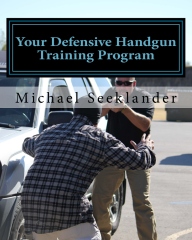 Editor’s Note: This is an excerpt from Mike Seeklander’s new book “Your Defensive Handgun Training Program“.
Editor’s Note: This is an excerpt from Mike Seeklander’s new book “Your Defensive Handgun Training Program“.
In addition to the four performance related factors I went through in part 1 of this article, I would also try to select a firearm that meets some (or all) of these secondary considerations:
High Capacity
The more bullets I can carry in the gun, the less I have to reload it. I have no interest in having to reload during a fight, as doing so costs time that might allow my enemy to overcome me. The downside to a higher capacity gun is that they are usually thicker and harder to conceal, especially in an IWB holster (inside the waist band).
Lightweight
Heavy guns are harder to carry. I carry a small lightweight Smith and Wesson M&P C most of the time, and in some cases switch to a full size gun. When doing so I immediately notice the additional discomfort of having that extra weight pulling on my belt. Try to find a gun that is comfortable enough that you will be okay carrying it all the time.
Stock Ready
This means that I recommend you select a gun that is ready to carry right out of the box. The most likely replacement from the factory should probably be sights. High quality manufacturers offer “stock ready” guns right out of the box. There are some things to consider when “setting” up your gun though, and some aftermarket changes are a good thing. Others are probably not recommended. The following will provide that information.
Firearm Setup
The set up of the gun is critical to how it performs. If your gun met the criteria listed earlier, there should be little additional setup needed, and there might actually be a danger in changing certain things in a stock firearm. I strongly recommend shooting the gun as close to the factory configuration as possible, as high quality companies build their guns to meet certain specifications. Modifying or changing parts to the newest gimmick of the day might compromise how the gun is supposed to work, and hinder its reliability. Here are the key factors that should be dealt with when setting up a gun:
Trigger
Be very careful when modifying the trigger system on a carry gun. Making a carry gun trigger very light is probably not a good idea, from both a performance perspective as well as a legal one (if you ever have to go to court over a shooting). The performance downside is that an extremely light trigger is higher risk in terms of potentially having an accidental or early discharge of the firearm while under stress. Light competition type trigger jobs are also prone to cause malfunctions due to light strikes caused by using less than factory weight springs. Legally, any modification that may make it seem like you are interested in making your firearm more “lethal” is probably something an attorney will use against you. I recommend sticking to the stock trigger weight (whatever comes from the factory), and think that it is probably ok to “clean” the trigger up on a carry gun to make it smoother. On the other side of the coin are the heavy trigger systems similar to the NY style trigger on a Glock. I feel that heavy a trigger system to prevent accidental discharges indicates that the shooters are very untrained, and certainly do not recommend them for a carry gun if you are committed to training and the basic principle of keeping your finger off the trigger until you have made the decision to shoot.
Sights
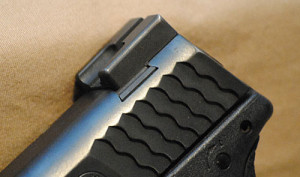
HIGHLY recommend Dawson “Charger” rear sights are designed for carry (this picture is my S&W 9C carry gun), and are built to allow for one handed malfunction manipulations by hooking the rear sight to work the slide. Notice the solid construction. You can find them at www.dawsonprecision.com.
Sight replacement is something I recommend unless the gun can be ordered with good carry sights. The criteria I am looking for on a carry gun are as follows:
- Solid design (metal, not plastic)
- Visible (larger rear sight notch, and fiber optic or tritium front sight)
- Snag free (no sharp corners or areas that will snag or tear your clothing during the draw process)
- One-Handed useful- I like a rear sight (such as the Dawson Charger) that allows the operator to use it to work the slide during survival shooting situations where one hand is occupied or injured and cannot be used.
Note on night sights
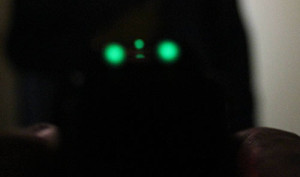
You can see the night sights in this level of darkness, but you could not identify whether or not the person is a threat without a light. This is why I don’t think night sights are mandatory on a carry gun.
You might be surprised to see I did not mention “night sights” in my criteria. While I have some guns with night sights, and do not have anything negative to say about them, I have found through testing that they are much less needed than most people think. Here’s why: In order to see most night sights glow (which is what makes them unique and work) it has to be dark enough that the shooter must use a flashlight to illuminate and “identify” a threat in order to make a decision to use lethal force. So…. if night sights are the ticket, but you have to have a light to clearly identify in most cases…. then I am not inclined to tell you that you must have them. Now, if you do have them on your carry gun, great, but before you run out and spend the money on them try this: get a pair of night sights and wait until it is dark enough to see them really glow. Now have a friend dressed in a dark shirt place something in their hand (something dark like a T.V. remote control) and have them get 10 yards or so away from you and hold this object near their waist area. You will find that the light is probably low enough to prevent you from seeing what it is. Some of you with very good vision will be able to pick the object out, but most will have to use some sort of light to be certain of what the person has in his/her hands. Remember, “mistake of fact” shootings are those that happen commonly in the Law Enforcement circles when an officer makes a mistake about what someone had in their possession. These shootings very often occur during low light situations. Learn from them!
Grip Surfaces
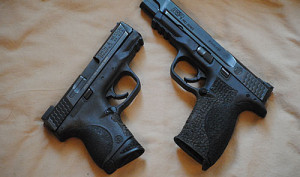
You can see the textured grip surfaces on these guns. Both have been stippled to increase the friction between the hand and the grip. Beware of over stippling a carry gun though, as it will tear your cloths and skin up.
To increase your ability to control the recoil, and manipulate the gun, all allowable grip surfaces should be stippled or coated with skateboard tape, with the exception of the back strap of the gun. The backstrap of the gun should be left relatively smooth to allow the strong hand to index the gun properly and slide up to a high grip position on the tang of the weapon during the draw process. I prefer stippling on carry guns as I can adjust the sharpness (with a file) of the edges, so if a gun is tearing up my side or cover garments, I can make the surface less aggressive. I strongly recommend this modification for carry guns, especially if one might be shooting with sweaty or bloody hands.
Manipulation devices (magazine release, slide lock/release, de-cocker, etc.)
Manipulation devices are those that allow you to release the spent magazine, slide, and de-cock the gun (if the gun has a de-cocking device).
- Magazine release- Use caution with extended magazine releases to ensure they do not allow the magazine to fall out or get snagged on clothing, but they should be considered for those who cannot reach the button without pivoting the gun in their hand. There are several great guns on the market today that have the feature of allowing the user to switch the magazine release to the other side of the gun, strongly benefiting those who shoot with their left hand, as most guns are right hand friendly.
- Slide Lock/Release lever- An extended slide lock/release lever should be considered for those who cannot reach the release without moving the gun in their hand, but again I caution you to test the device and ensure that reliability is not compromised. Once again, there are a couple manufacturers that are building guns with ambidextrous slide lock/release levers. Truthfully, I advocate simply manipulating the slide with a gross motor movement instead of using a slide lock in most cases.
Your Defensive Handgun Training Program is the most advanced training program you will find with the purpose of training those who might use a handgun for defensive/combative purposes to the highest level possible. If you have ever wondered what you should be doing on the range while you spend your precious time and ammunition preparing for a lethal encounter, this book will give you the answer. CLICK HERE TO ORDER…

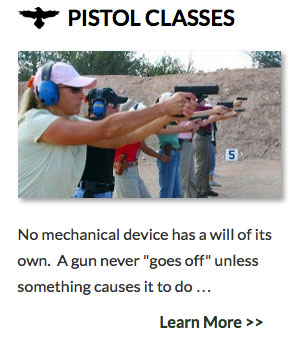

 MidwayUSA
MidwayUSA Ruger Firearms
Ruger Firearms SCCY Firearms
SCCY Firearms Streamlight
Streamlight Action Targets
Action Targets Gunsite Academy
Gunsite Academy
You must be logged in to post a comment Login